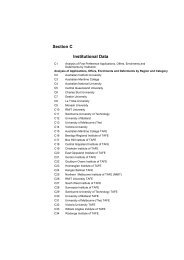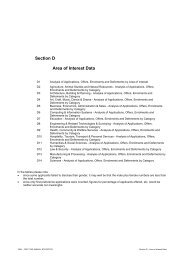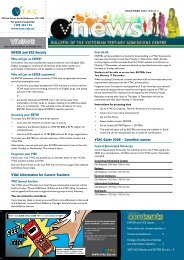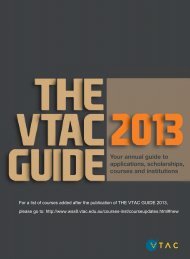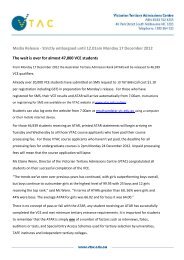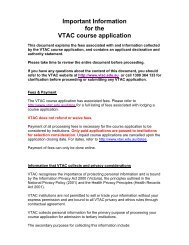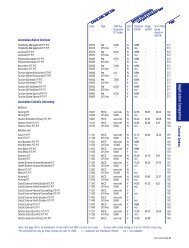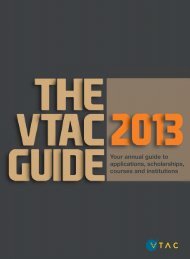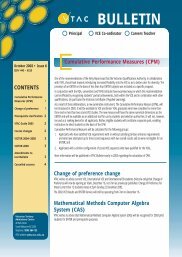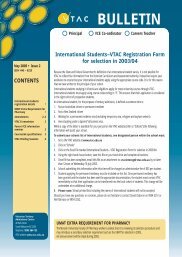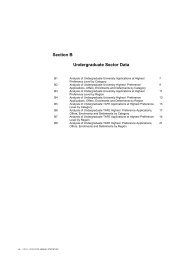VICTER 2015: Victorian Tertiary Entrance Requirements - VTAC
VICTER 2015: Victorian Tertiary Entrance Requirements - VTAC
VICTER 2015: Victorian Tertiary Entrance Requirements - VTAC
You also want an ePaper? Increase the reach of your titles
YUMPU automatically turns print PDFs into web optimized ePapers that Google loves.
While your score will be scaled up, it is unlikely that your scaled score<br />
would be any higher than if you had chosen a more suitable study, even<br />
one that is scaled down.<br />
The way to ensure that you achieve your best ATAR is to choose your<br />
studies according to what you are interested in; what you are good at;<br />
and what studies you need for future study.<br />
The calculation of the ATAR guarantees that all studies are treated<br />
equally and provides you with a common score for tertiary selection<br />
across Australia.<br />
Studies with additional scaling<br />
Mathematics<br />
VCE Mathematics studies are designed to cater for students of<br />
differing abilities and interests. Specialist Mathematics is the most<br />
difficult, followed by Mathematical Methods (CAS) and then by Further<br />
Mathematics.<br />
To ensure that students undertaking the more difficult mathematics<br />
studies are not disadvantaged, all three mathematics studies are<br />
scaled against each other as well as being scaled against all other<br />
studies. The higher of the two resulting scales is used.<br />
Languages<br />
As a result of government policy to encourage the study of languages,<br />
a further adjustment is made during the scaling process. Each VCE<br />
Language is adjusted up by adding five to the initial scaled score<br />
average. All students of a VCE Language receive an adjustment, but<br />
it is not a uniform adjustment. For study scores at or close to 30, the<br />
adjustment is 5, but the adjustment decreases as the study score<br />
moves away from 30.<br />
Studies used for the ATAR<br />
Subject to the rules and restrictions that are described in<br />
the sections that follow, the studies that can be used for the ATAR are:<br />
• All VCE Unit 3 and 4 sequences<br />
• Vocational Education and Training (VET) Programs with Unit 3 and<br />
4 sequences<br />
• Approved Higher Education studies.<br />
VET Programs<br />
VET programs that contribute to the VCE are used in the calculation of<br />
the ATAR as follows:<br />
VCE VET Unit 3 and 4 sequences with scored assessment:<br />
• study scores are scaled and may be included in the calculation of<br />
the ATAR aggregate<br />
• where a scored assessment is available and you decide not to take<br />
it, no increment will be available.<br />
VCE VET Unit 3 and 4 sequences with no scored<br />
assessment available:<br />
• may be counted as fifth and sixth studies. The increment will be<br />
10% of the average of the primary four scaled scores.<br />
If you have completed two VET Unit 3 and 4 sequences deemed by the<br />
VCAA to be equivalent because of significant duplication only one result<br />
can contribute to the ATAR. If one sequence has scored assessment<br />
available, then your result in the scored sequence will be used in the<br />
calculation of your ATAR. If both sequences have scored assessment,<br />
then the higher result will be used. If neither sequence has scored<br />
assessment, one VET increment will be available.<br />
Restriction on use of VET results within an Industry Area<br />
Only in cases where no scorable sequence in an industry area has been<br />
attempted, can two VET increments from that area contribute to the<br />
ATAR.<br />
Where a single scorable VCE VET sequence has been attempted in an<br />
industry area, then that result will be the first possible industry area<br />
contributor to the ATAR, and at most one increment can be added by<br />
non-scorable VET or VFE sequences in the same industry area.<br />
Where two scorable non-equivalent VCE VET sequences have been<br />
attempted in an industry area, then those results will be the first<br />
possible industry area contributors to the ATAR, and at most one<br />
increment can be added by non-scorable VET or VFE sequences in the<br />
same industry area.<br />
Where more than two scorable non-equivalent VCE VET sequences<br />
have been attempted in an industry area, then only those results will be<br />
possible industry area contributors to the ATAR, with at most two being<br />
permissible in the primary four and at most three being permissible in<br />
the ATAR.<br />
It should be noted that VET sequences within the Information<br />
Technology industry area are also considered to be in the IT Studies<br />
study area, whilst VET sequences within the Music Industry area are<br />
also considered to be in the Music Studies study area.<br />
Restriction on use of VFE Block Credit in the ATAR<br />
calculation where a student has previously been awarded<br />
an ATAR<br />
In cases where a student was previously eligible for an ATAR, new VFE<br />
results only contribute to the ATAR when fewer than six VCE and VCE<br />
VET results are available.<br />
Approved Higher Education studies in schools<br />
The VCAA provides for very able students to have an opportunity to<br />
undertake an approved Higher Education study as part of the VCE. Such<br />
studies are recognised as Higher Education studies contributing to<br />
completion of the VCE. Higher Education studies include first year<br />
university studies and advanced standing TAFE courses recognised by<br />
the VCAA and made available to VCE students who are very able<br />
academically and have the endorsement of their school principal.<br />
If you are undertaking such a study, it may count as an increment<br />
(fifth or sixth study) in the ATAR provided that it is passed, that VCAA<br />
co-requisite or prerequisite conditions were met, and subject to the<br />
restricted study combinations below.<br />
Upon satisfactory completion an increment will be awarded for the<br />
Higher Education study and will be determined as follows<br />
• Where a student completes a Higher Education VCE study and<br />
the average mark over all the HE units awarded is at least 90, the<br />
Higher Education increment will be 5.0.<br />
• Where a student completes a Higher Education VCE study and the<br />
average mark over all the HE units awarded is at least 80 but less<br />
than 90, the Higher Education increment will be 4.5.<br />
• Where a student completes a Higher Education VCE study and the<br />
average mark over all the HE units awarded is at least 70 but less<br />
than 80, the Higher Education increment will be 4.0.<br />
• Where a student completes a Higher Education VCE study and the<br />
average mark over all the HE units awarded is at least 60 but less<br />
than 70, the Higher Education increment will be 3.5.<br />
• Where a student completes a Higher Education VCE study and the<br />
average mark over all the HE units awarded is at least 50 but less<br />
than 60, the Higher Education increment will be 3.0.<br />
Australian <strong>Tertiary</strong> Admission Rank (ATAR)<br />
7




